Richard Garriott was a remarkable kid, but he was also a teenage dungeon master. So if we cringe a bit when Akalabeth opens with what seems a veritable caricature of teenage-dungeon-master speech which we can imagine issuing from some spotty kid in the lunch room crouching behind his Keep on the Borderlands adventure-module cover, we’ll also have to accept it as a product of its time and of its maker’s time of life.
Just a couple of idle muses, issued in said spirit of acceptance:
Why do writers of medieval fantasy (including plenty who ought to know much better than our young Mr. Garriott) always turn to the Renaissance-era Shakespeare when they want to make their English diction sound all high-falutin’ and authentic-like? There is a fellow named Geoffrey Chaucer, you know…
And given Garriott’s documented dissatisfaction with the approach Crowther and Woods took in Adventure, is “Beyond Adventure” (or should I say “Beyond Adventure“?) a not-so-subtle dig at the competition?
While both of his parents and presumably others of course offered ideas and suggestions, Akalabeth is completely the work of Richard alone, the culmination of three years of tinkering, first on that teletype terminal in his high school and then on his shiny new Apple II Plus. The one exception comes in the form of title graphics, provided by a Houston neighborhood friend, Keith Zabalaoui, and sufficient to earn him a “Graphics” credit on the packaging.
After we have paged through Zabalaoui’s title graphics and the in-game instructions, the BASIC code of the game itself is loaded in and run. Everything that follows is implemented in a single BASIC program of some 22 K. First, we are told to “Type thy lucky number.” This number will serve as a seed to the random-number generator, determining almost everything that follows: the attribute scores we begin with, the layout of the wilderness and dungeon maps, etc. Thus, typing the same lucky number effectively guarantees us the same game, right down to the character we start with, and doing the exact same thing from there will literally result in the exact same game, for even “random” die rolls are ultimately controlled by this magic number. Generating a virtual world mathematically, on the fly as needs must rather than storing it as prepared data that simply needs to be retrieved from disk, was by no means unheard of in other early computer games that struggled with their hosts’ limited memories and disk capacities; most famously, Elite built its whole eight-galaxy universe dynamically from Fibonacci sequences. It is interesting that Garriott chose that approach here, however, rather than just using the Apple II’s perfectly adequate “real” random-number generator to present a truly random storyworld and gameplay.
Anyway, after making that most critical of decisions we next get to choose a difficulty level of between 1 and 10, which controls how tough the monsters we fight will be and how many quests we will need to complete to win the game. Next we see our character, consisting of a subset of the typical Dungeons and Dragons markers: hit points, strength, dexterity, stamina, wisdom, gold. We also can choose between two classes, fighter or mage. And so we end up in the inevitable shop, although this time without the chatty shopkeepers and haggling of Temple of Apshai or Eamon.
Like Temple of Apshai, Akalabeth‘s equipment list is pretty basic, consisting of just the handful of generic items shown above, without even any possibility of finding special loot in the dungeons. Notably, however, here we have to deal with maintaining our food supply; our avatar will consume a little bit of food with every single turn, and if we run out he dies instantly. Starvation can be a real threat early in the game when gold is scarce, but soon enough we can afford hundreds of packages of food, and death by starvation becomes likely only through carelessness.
When the game proper begins, the basis of Garriott’s only half joking assertion that he spent the first 15 years of his career making the same game over and over really becomes clear. We are presented with an outdoor map, seen from an overhead perspective, which we navigate around using one-key commands. Any Ultima veteran should feel right at home, although unlike in the Ultimas, which eventually grew to use just about every key on the keyboard, we have just 10 or so options, most dealing simply with movement.
Note that the display above is implemented using the Apple II’s unique hi-res graphics mode with four lines of regular text at the bottom for status messages — Wozniak’s gift that kept on giving for game programmers.
Also like in later Ultimas, our first real mission must be to find the castle of Garriott’s alter ego, Lord British. After calling us a “peasant” (tell us how you really feel, Richard), he will assign us the first of a series of “quests” to simply kill monsters of increasing difficulty. The number of these quests we must complete to win the game is controlled by the difficulty level we chose at the beginning.
Isn’t that “a(n)” bit above priceless?
It’s in the dungeons scattered around the outdoor map that we find monsters to fight. These dungeons are the real meat of the game; we’ll spend most of our time exploring and mapping them and of course fighting their inhabitants, which grow increasingly fearsome as we descend to lower and lower levels. It’s also here that we find the game’s most obvious formal innovation, its use of a three-dimensional, first-person perspective that puts us right into the storyworld.
The use of such a perspective was not completely unprecedented even in 1980; there was of course that Escape game that had inspired Richard in the first place. And better remembered is Flight Simulator, the fruit of many years of 3D graphics experimentation by Bruce Artwick, which first appeared on the Apple II in 1979 or very early 1980. Garriott was, however, the first to implement it in a CRPG. As such, it would be very influential on a whole generation of dungeon-crawl games to follow, even as Garriott’s own Ultima series would ironically place increasingly less emphasis on its own dungeon delving in favor of creating ever richer above-ground worlds. And if we take Akalabeth‘s 3D dungeons out of the strict context of CRPG history, they stand near the top of a slippery slope that eventually led to Doom and, well, most of the hardcore games of today.
Still, Akalabeth isn’t generally accorded a whole lot of respect as a game qua game today. The CRPG Addict, for instance, calls it “more of a demonstration project than a game.” Certainly the garish artwork and teenage DM diction make it seem even more of an amateurish creation than most games from its early era. There’s some fitful stab at a milieu and a story, but it doesn’t really make any sense in light of the player’s goal to simply kill monsters and become a knight; after the introductory stuff, there are fewer total words in the game proper than there are in this paragraph. And there are things that feel just plain odd. For instance, Akalabeth has no concept of character levels; after exiting from a dungeon you are rewarded only in hit points, based on the quantity and quality of monsters you slew down below. The game has no concept of healing or of some theoretical maximum hit-point value; hit points are simply a collectable commodity, like gold. This system would persist even into Ultima I. As the CRPG Addict notes about that game, “it[‘s] the only game I know in which when you’re low on hit points, you’d better head straight for the nearest dungeon and find some monsters to fight!” Counter-intuitive as it is, fighting is literally the only way to recover hit points. (Which means, of course, that if you somehow manage to run your hit points too low without killing some pretty tough monsters, you’re effectively screwed.)
Yet there’s also a surprisingly smart design sensibility in evidence here in addition to the technical innovation of the 3D dungeons. These are aspects for which Akalabeth doesn’t get enough credit. In fact, I was surprised at how playable Akalabeth really is — much more playable than, say, the more conceptually ambitious Temple of Apshai and its successors. Part of the problem others have had with it may be a failure of expectations. Akalabeth is not trying to give its player an extended, epic experience like its Ultima successors; it does not even have a save capability. It’s rather designed as a replayable exercise in dungeon delving. The difficulty system assures that the player is always challenged, and the magic-number system allows her to generate an almost infinite variety of maps while also being able to return to exactly that pesky setup that got her killed last time, should she so desire. Taken in that light, Akalabeth is a remarkably forward-thinking, even player-friendly design for its era. And while I won’t say that I was captured for days by it or anything, I genuinely had fun toying around with it in preparation for writing this entry, something I certainly can’t say about all of the historically important early games I’ve covered previously.
Other common criticisms provide an object lesson on the need to do this sort of software archaeology using as authentic a setup as possible. In 1997, Electronic Arts released The Ultima Collection, a collection of the first eight games in the series. They also included as a bonus a port of Akalabeth to MS-DOS, marking the first such ever done after the Apple II original. Most people who attempt to play Akalabeth today use this version, as it is more accessible than getting a real Apple II or Apple II emulator working. The problem is, this version actually appears to be less sophisticated than its antecedent. For instance, in the port every single dungeon on the map is a clone of every other; in the original, each dungeon is unique. Thus we are left with a false and unfavorable impression of Garriott’s original design.
Another common criticism is that the magic amulet effectively breaks the game. Some quick background: one of the items the player can buy or find in dungeons is a magic amulet, which, in addition to a few usefully predictable functions such as making magic ladders to move up or down in a dungeon, also has a sort of wildcard option. Most of the time the results of choosing this are bad in the extreme, such as being turned into a toad. Occasionally, however, the player will get turned into a lizard man, which might not sound so great but actually is: all of her stats instantly and permanently increase by 150%. The exploit, then, is to save the game — a feature the MS-DOS port, unlike the original, did include — and try your luck. If something bad happens, you simply restore and try again, until you become a lizard man. Do this a few times and you are effectively invincible. Fine — but we need to remember that players of the original didn’t have the comfort of a save command, or even an emulator’s saved state. So trying this would have been a truly desperate roll of the dice, probably undertaken when the player had nothing left to lose. Seen the way a player in 1980 would have seen it, it’s not a game breaker at all, but a clever touch that just might once in a blue moon provide a miracle to the desperate.
So, taken all in all, it’s not hard to see why the software publisher California Pacific came calling after Richard, wanting to give his game a national release. I’ll get into that story next time.
If you’d like to try out the original Akalabeth for yourself in the meanwhile, here’s an Apple II disk image for ya.
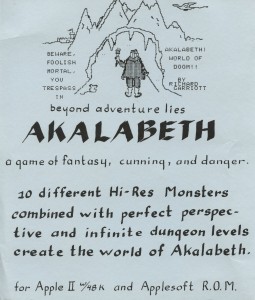
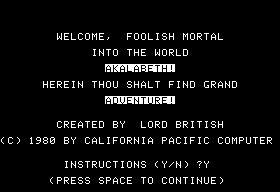
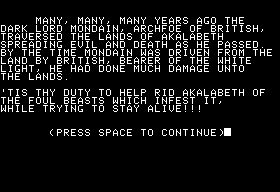
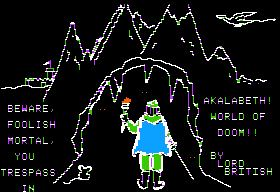
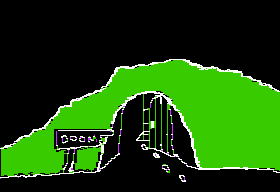
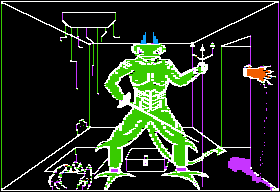
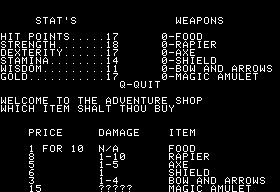
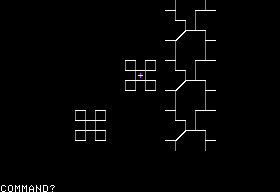
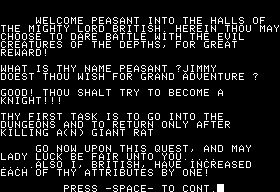
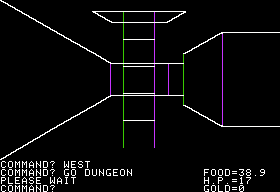
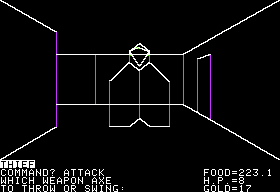











Sam Kabo Ashwell
December 18, 2011 at 10:26 pm
Why do writers of medieval fantasy (including plenty who ought to know much better than our young Mr. Garriott) always turn to the Renaissance-era Shakespeare when they want to make their English diction sound all high-falutin’ and authentic-like? There is a fellow named Geoffrey Chaucer, you know…
Two possible factors:
1) Fantasy audiences don’t really want medieval: they want very late medieval shading into Renaissance. They want full plate mail, rapiers, freedom of movement, big cities full of skilled craftsmen, inns, a middle class, widespread literacy, age-of-sail ships, etc. Proper medieval is too alien a world for most people to feel comfortable in.
2) Shakespeare is much more widely-read than Chaucer. Also more-read than Chaucer: the KJV, which was designed to sound archaic when first published and thus works perfectly as a cod-medieval sourcebook.
Nathan
December 19, 2011 at 2:13 am
Besides, the teenage kids popular fantasy depends on can actually read quasi-Shakespearean English. You really can’t say the same for Chaucer.
S. John Ross
December 19, 2011 at 2:32 am
Sam Kabo Ashwell provided the same responses I would have, though I’d more heavily emphasize his point (1), since a lot of fantasy gaming springs from Dungeons & Dragons traditions, specifically, which is very much set in Ye Merrye Renfaire Age (a period of history formally extending from the late Bronze Age to the latter days of the the American Wild West, but focused somewhere squarely between Shakespeare and the King James, but with half-dressed elf maidens and fireballs).
And, frankly, while I’d do the Wife of Bath as quickly as anyone (quicker, to give her more time for others), Chaucer’s English barely registers as _English_ to most readers; it would be a vain, pretentious cruelty to try to impose it on the public without their explicit and masochistic consent.
Sam Kabo Ashwell
December 19, 2011 at 3:07 am
I think of Chaucerian English as pretty readable, but that’s because I find it hilarious and have therefore spent a fair amount of time with it. And I certainly can’t improvise in it, which is what RPGs require.
S. John Ross
December 19, 2011 at 3:24 am
I’m comfortable reading Chaucer, as well (and ditto on the high-larious) … but If you believe it’s readable to Joe Random Fantasy Enthusiast, I would recommend some kind of spot-testing experiment performed at your local game retailer or bookshop :)
I occasionally improvise “Chaucerian” in my games if the point is that an NPC is a blowhard or too ancient to work a VCR, that kind of thing. Or if I’m mocking Lisa Steele in subtle ways, but that’s a long story (love ya, Lisa).
Jimmy Maher
December 19, 2011 at 8:24 am
It was kind of a stupid question, wasn’t it? Thank you all for not giving stupid answers!
I’ve actually been reading Chaucer lately for the first time in years, so he was on my mind when I wrote this entry. I had a somewhat hard time even finding a book with the original text (I still like to do my more “serious” reading on paper); it seems people mostly go for the modern translations. Kids today!
Speaking of kids and the original text, I remember what a pain in the ass I found it as a high schooler and undergrad to read. Surprisingly, I haven’t had much trouble with it this time. I’ve learned Danish and a lot more German since then, which helps I think. At least a lot of the words are familiar in an “Oh! That word was in English then?” sort of way, and the grammatical constructions are also more familiar (adjectives getting a -e ending in the plural, etc.).
Wouldn’t it be cool if we could know for sure what Middle English really *sounded* like?
Tale
December 19, 2011 at 4:25 pm
Jimmy,
I rarely comment because all this is very alien to me, but I read this with great interest.
Vielen Dank dafür! Ich hoffe deutsch lernen macht dir Spaß.
Jimmy Maher
December 20, 2011 at 9:41 am
Bitte schön. Ich finde die deutsche Sprache schwerer als Dänisch oder Norwegisch zu lernen, aber sie gefällt mir immerhin.
NorkaBoid
September 17, 2015 at 1:25 pm
Isn’t that “a(n)” bit above priceless?
From the label on one of my prescriptions: “This medicine is a(n) green and orange, oblong-shaped capsule…”
The legacy of young Lord British lives on!
NorkaBoid
September 17, 2015 at 1:43 pm
Oops, I forgot to italicize the quote on the first line. Guess I should just take these oblong-shaped capsules instead of posting extemporaneous comments about them.
Ahab
January 21, 2019 at 2:41 pm
He actually did just use the standard RNG built into BASIC, and not Fibonacci sequences or anything else expressly mathematical The BASIC code is easily extracted from the disk image and read. All he does is seed the RNG with your lucky number and reseeds it with the lucky number and coordinates whenever entering a dungeon. Seeding it with the same number gives the same pseudo-random sequence every single time.
I did recently beat this game in its Apple II version on the highest difficulty, and I don’t see how you’re supposed to beat it without abusing the Lizard Man effect, which is still easy and game breaking in the Apple II version thanks to a predictable RNG. Monsters take forever to kill with normal stats, and gremlins steal half your food every other turn. I tried being a mage and farming gold so that I could just buy lots of amulets and ladder past the gremlins, but thieves are on every level, and they too take forever to kill at lower levels and keep stealing your expensive weapons and amulets.
It also might be literally impossible to beat the game if your dexterity is too low. Balrogs on level 9 have an effective AC of 19, and the formula to miss enemies is [DEX – random(0-24) < monster AC]. That goes for the Kill spell too. If Lord British asks you to kill a Balrog, and your dexterity isn't at least 20, you have no chance to even hit the Balrog, and no way to raise your DEX except through Lizard Man transformation.
Nicholas Bond
September 30, 2019 at 4:55 pm
I feel like Akalabeth comes really close to something playable, but doesn’t quite make it. As you say, this is a dungeon-crawling game, something that Ultima ends up de-emphasizing to such an extent that it ends up feeling tacked on. So direct comparisons to Ultima probably aren’t fair, and in fact it’s probably unfair to judge this as an RPG, because its mechanics simply to don’t allow character building on story development.
My sense is that this is actually closer to a survival horror game. I elaborate on this a bit in my blog, but I think only a few changes would be necessary for it to be a lot more fun. You compare it to Doom, which also straddles the survival horror genre, and I think that’s a reasonable comparison as well.
Of course, this game came well before video game genres were well-defined, so it’s fascinating to see what a nearly blank slate approach to a dungeon crawler comes out looking like. I had some fun with it as well, though I don’t think CRPG Addict is too far off the mark in calling it a demo. Some of the play elements are really imbalanced, like the gremlin and the amulet.
Michael
November 25, 2019 at 11:27 pm
“And given Garriott’s documented dissatisfaction with the approach Crowther and Woods took in Adventure, is “Beyond Adventure” (or should I say “Beyond Adventure“?) a not-so-subtle dig at the competition?”
I’ve strained my eyes staring at the screen shots, and I cannot find the phrase “Beyond Adventure” ANYwhere. I see “Herein thou shalt find grand adventure” in the first screen, and then there’s another reference to “grand adventure” much later on.
What am I missing?
Jimmy Maher
November 26, 2019 at 8:56 am
It’s actually on the packaging, which was shown in the previous article. But it obviously ought to be here as well. Thanks!
Michael
November 27, 2019 at 6:14 pm
Ah ha! Thank you.
Ben
April 20, 2020 at 8:49 pm
a whole of respect -> a whole lot of respect
Jimmy Maher
April 21, 2020 at 9:55 am
Thanks!
Simon
October 23, 2020 at 5:29 pm
“We are presented with a outdoor map …”
a(n) outdoor map? ;)
Jimmy Maher
October 25, 2020 at 9:18 am
Thanks!
Peter Olausson
March 3, 2021 at 7:30 pm
They should have renamed “Ultima Thule” “Akalabeth” instead of “Arrokoth” :-)
https://en.wikipedia.org/wiki/486958_Arrokoth
_RGTech
November 4, 2023 at 9:46 am
Shouldn’t the “random die rolls” be “dice rolls”?
If so: amazing that all the commenters in the last 10+ years didn’t catch that one :)
Jimmy Maher
November 6, 2023 at 10:18 am
It could go either way, depending on whether you wish to think of the computer as rolling one die or many.
Emilia Hanes04
December 27, 2024 at 7:36 am
Fascinating read! I suddenly found out about Ultima and therefore Alakabeth because I was looking into reddit threads of the NES game “Fire Emblem: Shadow Dragon & The Blade of Light”, and someone mentioned it was tied for their favorite NES game alongside Ultima III. Fascinating RPG history here, as a huge RPG fan (but leaning into JRPGs more than western-style RPGs).
I wonder if I would be old school enough to enjoy playing Alakabeth… as with most things, I would play it on original hardware or an emulator but how one would get to emulate the Apple II certainly sounds more technical than emulating a typical videogame console.